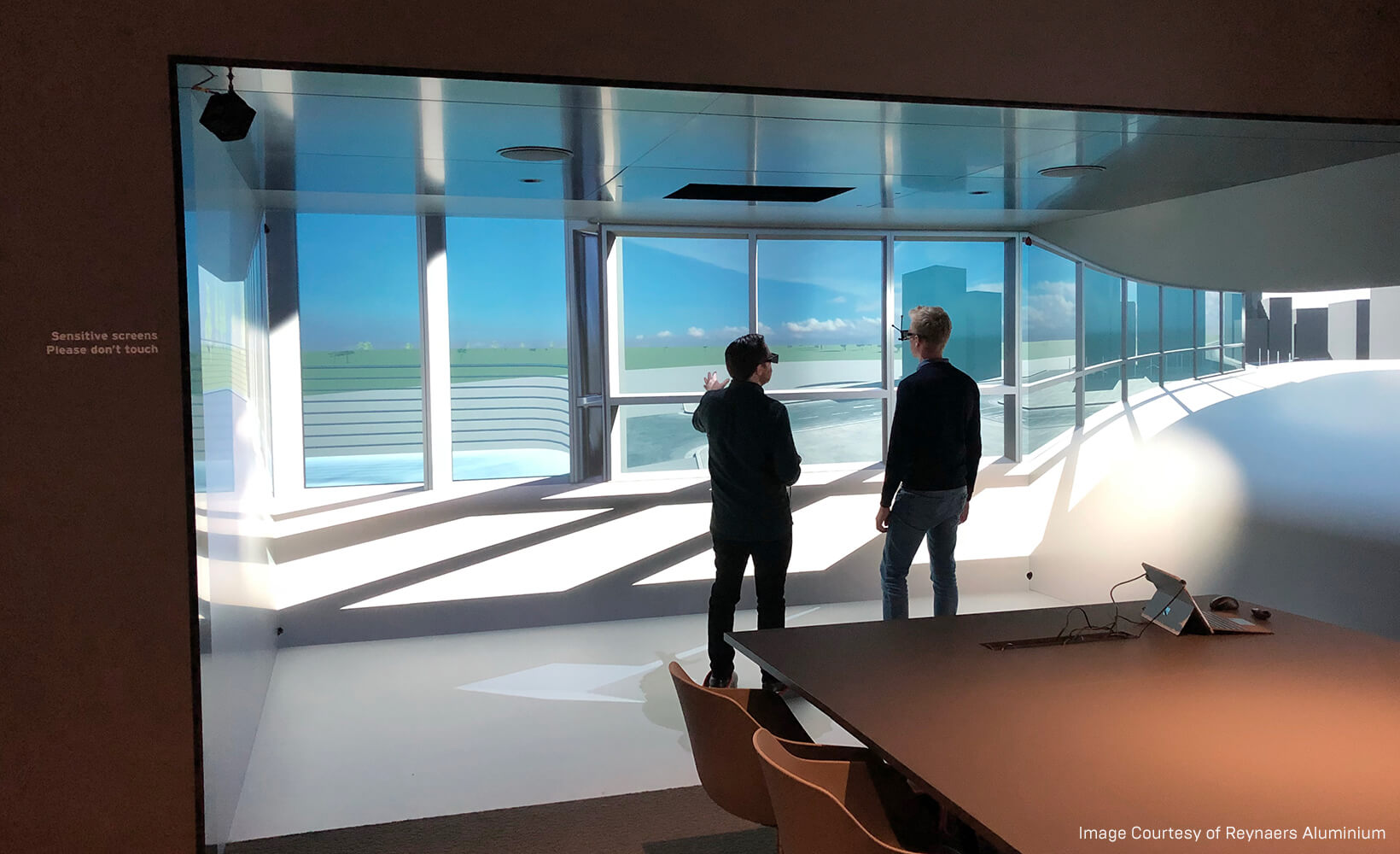September 20, 2018
Reynaers Aluminium makes design accessible with VR CAVE
As part of their hands-on approach to design, Reynaers Aluminium created a five-sided cave automatic virtual environment (CAVE) dedicated to architectural visualization at their headquarters in Duffel, Belgium. Inside the CAVE, dubbed AVALON, visitors can explore a yet-to-be-built structure inside and out, seeing the three walls around them as well as the floor and ceiling. With active see-through 3D glasses, visitors can see and interact with each other as well as the projected design.

AVALON serves multiple purposes for Reynaers Aluminium and their clients. “We supply a wide range of standard window and façade solutions, and also tailor-made systems for challenging building designs,” says Stefan Vandervelden, Head of Research Projects at Reynaers. “An architect can discuss variations for shape or placement of our solutions, thicker frames versus thinner, straight versus faceted, and so on. They can evaluate different options until everyone is satisfied.”
AVALON also provides a means for answering builders’ questions on installation and technical feasibility. “It’s not just about the aesthetics,” says Vandervelden. “Any custom frame configuration has to consider the stresses of that environment, and is designed to be assembled a certain way. Our systems often contain complicated technical concepts, which can be hard to explain on paper or computer screen but easy to show in 3D. In AVALON, we can educate building professionals visually on all these factors.”
AVALON inherently inspires curiosity. After settling design or construction decisions, visitors often stay in the CAVE for an extended period of time, exploring the architect’s design. AVALON has hosted more than 3,000 visitors since its opening in mid 2017, and is booked for months to come.
“We have faraway clients who fly out here just to see their designs in AVALON,” says Nina Timmermans, Product Manager BIM & VR at Reynaers. “It’s a lot more effective than a flat blueprint for discussing the advantages of different options.”
The AVALON Facility
The idea for AVALON came about a few years ago when Reynaers Aluminium was designing an extension to its headquarters complex. While looking for ways to bring both experience and added value to building teams visiting the Reynaers Campus, they came up with the idea for an immersive CAVE.
With the goal of building an immersive environment where anyone could explore and understand design even if they had no experience with architecture or engineering, they teamed up with Barco, a global technology leader in networked visualization and collaboration solutions, and integrator Nanco. The result was AVALON, which might just be the most impressive cave ever created just for the AEC industry.

The AVALON system uses 25 Barco laser projectors calibrated to project overlapping imagery for a seamless view of the structure on all five walls. The system uses Unreal Engine running on 14 workstations with NVIDIA Quadro cards to update the scene in real time during navigation. “We had reached a time when the technology and software was all there,” says Damien Conroy, Visualization & VR Specialist at Reynaers Aluminium. “The only challenge left was putting it all together.”
The team uses VR head-mounted displays at events and fairs, but it’s just a teaser for the real thing. “The problem with headsets is that they isolate the viewer and you lose communication,” says Nina Timmermans. “That’s fine for a solo VR experience, but we wanted groups to be able to see and interact with one another while inside the CAVE.”
The active VR glasses used in AVALON offer a natural field of view and, combined with the laser projectors, show Unreal Engine content at a high resolution. Within the CAVE, one user controls the view with a joystick while others observe. “Because of the see-through glasses, visitors can see the projection and each other at the same time,” says Nina Timmermans. “You can point at something, look at it together, and have a normal discussion with the person standing next to you.”

The AVALON team receives models from architects in a variety of formats—SketchUp, Revit, ARCHICAD, 3ds Max, and sometimes even Unreal Engine project files. For CAD files, the team imports them to 3ds Max, and uses the Datasmith plugin included with Unreal Engine to port the files from 3ds Max to Unreal Engine. Visuals in AVALON are designed to approach photoreal quality and play back at a VR-comfortable 60fps.
“With Unreal Engine, we can have textures, reflections, everything we need to approach photorealism,” says Conroy.
After exploring the design in AVALON, visitors also visit the Technology Center and the digitally-enabled showroom, where they can see first-hand the physical products and the extensive test facilities. Between the digital 3D view in AVALON and the physical elements, clients get a full picture of the design and construction of their project.
The Future of AVALON
In future iterations of the system, the AVALON team plans to shorten pipelines, boost the photorealism, and keep adding functionality. Although there was a considerable initial expense, the AVALON team considers the added value for the engineering and design process, and for collaboration with building teams, to be priceless.
Want to experiment with virtual reality for your own designs? Download Unreal Engine for free and get started today!
